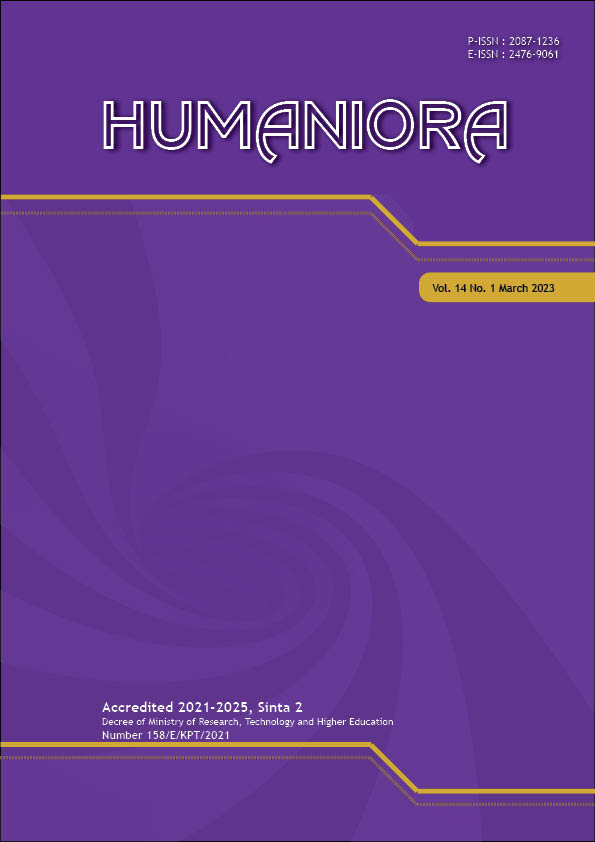The Role of Religious Coping in Moderating the Relationship between Stress and Non-Suicidal Self-Injury (NSSI)
DOI:
https://doi.org/10.21512/humaniora.v14i1.7907Keywords:
religious coping, NSSI, stress, emerging adultsAbstract
The cross-sectional research aimed to examine the relationship between stress, positive and negative religious coping, and Non-Suicidal Self-Injury (NSSI) severity. It was a global health issue with a high and increasing prevalence among emerging adults. Various factors’ roles in influencing the severity of NSSI had been explored, including stress and religious coping. Data were gathered from 311 emerging adult (age 18-29 years old) participants in Indonesia using an online questionnaire, which included measures of stress (the Perceived Stress Scale-10), positive and negative religious coping (the Brief RCOPE), and NSSI severity (the Non-Suicidal Self-Injury Function Scale). The research reveals that 40,2% of participants have engaged in NSSI. Analysis using simple regression indicates that an increase in stress predicted with statistical significance an increase in NSSI severity. Meanwhile, analysis using moderation demonstrates that negative religious coping has a statistically significant moderation effect on the relationship between stress and NSSI severity. However, moderation analysis indicates that positive religious coping does not have a statistically significant moderation effect on the relationship between stress and NSSI severity. Thus, stress and negative religious coping play important roles in exacerbating NSSI. The research illustrates the importance of prevention and intervention programs for NSSI targeting stress and negative religious coping.
References
Abu-Raiya, H., & Pargament, K. I. (2015). Religious coping among diverse religions: Commonalities and divergences. Psychology of Religion and Spirituality, 7(1), 24-33. https://doi.org/10.1037/a0037652.
Agnew, M., Poole, H., & Khan, A. (2019). Fall break fallout: Exploring student perceptions of the impact of an autumn break on stress. Student Success, 10(3), 45-54. https://doi.org/10.5204/ssj.v10i3.1412.
Alharbi, H., & Alshehry, A. (2019). Perceived stress and coping strategies among ICU nurses in government tertiary hospitals in Saudi Arabia: A cross-sectional study. Annals of Saudi Medicine, 39(1), 48-55. https://doi.org/10.5144/0256-4947.2019.48.
Anganthi, N. R. N., & Uyun, Z. (2019). The path of psychospiritual intervention for self-healing: The multi religion perspectives. Humanities and Social Sciences Reviews, 7(3), 176-180. https://doi.org/10.18510/hssr.2019.7327.
Ano, G. G., & Vasconcelles, E. B. (2005). Religious coping and psychological adjustment to stress: A meta-analysis. Journal of Clinical Psychology, 61(4), 461-480. https://doi.org/10.1002/jclp.20049.
Arshad, U., Farhat-ul-Ain, Gauntlett, J., Husain, N., Chaudhry, N., & Taylor, P. J. (2020). A systematic review of the evidence supporting mobile- and Internet-based psychological interventions for self-harm. Suicide and Life-Threatening Behavior, 50(1), 151-179. https://doi.org/10.1111/sltb.12583.
Bartelink, V. H. M., Zay Ya, K., Guldbrandsson, K., & Bremberg, S. (2020). Unemployment among young people and mental health: A systematic review. Scandinavian Journal of Public Health, 48(5), 544-558. https://doi.org/10.1177/1403494819852847.
Bauto, L. M. (2016). Perspektif agama dan kebudayaan dalam kehidupan masyarakat Indonesia: Suatu tinjauan sosiologi agama. Jurnal Pendidikan Ilmu Sosial, 23(2), 11-25. https://doi.org/10.17509/jpis.v23i2.1616.
Bentzen, J. S. (2021). In crisis, we pray: Religiosity and the COVID-19 pandemic. Journal of Economic Behavior and Organization, 192, 541-583. https://doi.org/10.1016/j.jebo.2021.10.014.
Bjureberg, J., Kuja-Halkola, R., Ohlis, A., Lichtenstein, P., D’Onofrio, B. M., Hellner, C., & Cederlöf, M. (2021). Adverse clinical outcomes among youths with nonsuicidal self-injury and suicide attempts: a longitudinal cohort study. Journal of Child Psychology and Psychiatry and Allied Disciplines, 63(8), 921-928. https://doi.org/10.1111/jcpp.13544.
Brausch, A. M., & Muehlenkamp, J. J. (2018). Perceived effectiveness of NSSI in achieving functions on severity and suicide risk. Psychiatry Research, 265, 144-150. https://doi.org/10.1016/j.psychres.2018.04.038.
Burlacu, A., Artene, B., Nistor, I., Buju, S., Jugrin, D., Mavrichi, I., & Covic, A. (2019). Religiosity, spirituality and quality of life of dialysis patients: A systematic review. International Urology and Nephrology, 51(5), 839-850. https://doi.org/10.1007/s11255-019-02129-x.
Buser, J. K., Buser, T. J., & Rutt, C. C. (2017). Non-suicidal self-injury and spiritual/religious coping. Journal of Mental Health Counseling, 39(2), 132-148. https://doi.org/10.17744/mehc.39.2.04.
Cipriano, A., Cella, S., & Cotrufo, P. (2017). Nonsuicidal self-injury: A systematic review. Frontiers in Psychology, 8, 1-14. https://doi.org/10.3389/fpsyg.2017.01946.
Cohen, J. (1988). Statistical power analysis for the behavioral sciences (2nd Ed.). New Jersey: Erlbaum.
Cohen, S., & Williamson, G. M. (1988). Perceived stress in a probability sample of the United States. In S. Spacapan & S. Oskamp (Eds.), The social Psychology of Health (pp. 31–67). California: Sage.
Elbogen, E. B., Lanier, M., Blakey, S. M., Wagner, H. R., & Tsai, J. (2021). Suicidal ideation and thoughts of selfâ€harm during the COVIDâ€19 pandemic: The role of COVIDâ€19â€related stress, social isolation, and financial strain. Depression and Anxiety, 38(7), 739-748. https://doi.org/10.1002/da.23162.
Ewing, L., Hamza, C. A., & Willoughby, T. (2019). Stressful experiences, emotion dysregulation, and nonsuicidal self-injury among university students. Journal of Youth and Adolescence, 48(7), 1379-1389. https://doi.org/10.1007/s10964-019-01025-y.
Exline, J. J., & Rose, E. (2005). Religious and spiritual struggles. In R. F. Paloutzian & C. Park (Eds.), Handbook of the Psychology of Religion and Spirituality. New York: Guilford Press.
Field, A. (2009). Discovering statistics using SPSS (3rd Ed). California: Sage Publications Ltd.
Fitchett, G., Murphy, P. E., Kim, J., Gibbons, J. L., Cameron, J. R., & Davis, J. A. (2004). Religious struggle: Prevalence, correlates and mental health risks in diabetic, congestive heart failure, and oncology patients. International Journal of Psychiatry in Medicine, 34(2), 179-196. https://doi.org/10.2190/UCJ9-DP4M-9C0X-835M.
Fowler, D. (2020). Unemployment during coronavirus: The psychology of job loss. Retrieved from https://www.bbc.com/worklife/article/20200327-unemployment-during-coronavirus-the-psychology-of-job-loss.
Fox, K. R., Franklin, J. C., Ribeiro, J. D., Kleiman, E. M., Bentley, K. H., & Nock, M. K. (2015). Meta-analysis of risk factors for nonsuicidal self-injury. Clinical Psychology Review, 42, 156-167. https://doi.org/10.1016/j.cpr.2015.09.002.
Francis, B., Gill, J. S., Ng, Y. H., Petrus, C. F., Azhar, F. L., Sabki, Z. A., Said, M. A., Koh, O. H., Ng, C. G., & Sulaiman, A. H. (2019). Religious coping, religiosity, depression and anxiety among medical students in a multi-religious setting. International Journal of Environmental Research and Public Health, 16(2), 1-13. https://doi.org/10.3390/ijerph16020259.
Funder, D. C., & Ozer, D. J. (2019). Evaluating effect size in psychological research: Sense and nonsense. Advances in Methods and Practices in Psychological Science, 2(2), 156-168. https://doi.org/10.1177/2515245919847202.
Gandhi, A., Luyckx, K., Baetens, I., Kiekens, G., Sleuwaegen, E., Berens, A., Maitra, S., & Claes, L. (2018). Age of onset of non-suicidal self-injury in Dutch-speaking adolescents and emerging adults: An event history analysis of pooled data. Comprehensive Psychiatry, 80, 170-178. https://doi.org/10.1016/j.comppsych.2017.10.007.
Germani, A., Buratta, L., Delvecchio, E., & Mazzeschi, C. (2020). Emerging adults and COVID-19: The role of individualism-collectivism on perceived risks and psychological maladjustment. International Journal of Environmental Research and Public Health, 17(10), 1-15. https://doi.org/10.3390/ijerph17103497.
Gholamrezaei, M., de Stefano, J., & Heath, N. L. (2017). Nonsuicidal self-injury across cultures and ethnic and racial minorities: A review. International Journal of Psychology, 52(4), 316-326. https://doi.org/10.1002/ijop.12230.
Griep, S. K., & MacKinnon, D. F. (2020). Does nonsuicidal self-injury predict later suicidal attempts? A review of studies. Archives of Suicide Research, 26(2), 1-19. https://doi.org/10.1080/13811118.2020.1822244.
Gunnarsson, N. V. (2021). The self-perpetuating cycle of shame and self-injury. Humanity & Society, 45(3), 313-333. https://doi.org/10.1177/0160597620904475.
Hamza, C. A., Ewing, L., Heath, N. L., & Goldstein, A. L. (2020). When social isolation is nothing new: A longitudinal study psychological distress during COVID-19 among university students with and without preexisting mental health concerns. Canadian Psychology, 62(1), 20-30. https://doi.org/10.1037/cap0000255.
Hamza, C. A., Goldstein, A. L., Heath, N. L., & Ewing, L. (2021). Stressful experiences in university predict non-suicidal self-injury through emotional reactivity. Frontiers in Psychology, 12, 1-12. https://doi.org/10.3389/fpsyg.2021.610670.
Hary, Z. A. P. (2017). Hubungan antara kelekatan terhadap ibu dengan tingkat stres pada mahasiswa perantau. Thesis. Yogyakarta: Universitas Sanata Dharma.
Hasking, P., & Boyes, M. (2018). Cutting words: A commentary on language and stigma in the context of nonsuicidal self-injury. Journal of Nervous and Mental Disease, 206(11), 829-833. https://doi.org/10.1097/NMD.0000000000000899.
Hasking, P., Lewis, S. P., Bloom, E., Brausch, A., Kaess, M., & Robinson, K. (2021). Impact of the COVID-19 pandemic on students at elevated risk of self-injury: The importance of virtual and online resources. School Psychology International, 42(1), 57-78. https://doi.org/10.1177/0143034320974414.
Hepp, J., Carpenter, R. W., Störkel, L. M., Schmitz, S. E., Schmahl, C., & Niedtfeld, I. (2020). A systematic review of daily life studies on non-suicidal self-injury based on the four-function model. Clinical Psychology Review, 82, 1-42. https://doi.org/10.1016/j.cpr.2020.101888.
Hill, P. C. (2005). Measurement in the psychology of religion and spirituality: Current status and evaluation. In R. F. Paloutzian & C. Park (Eds.), Handbook of the Psychology of Religion and Spirituality (pp. 43-61). New York: Guilford Press.
Hoyt, L. T., Cohen, A. K., Dull, B., Maker Castro, E., & Yazdani, N. (2021). Constant stress has become the new normal: Stress and anxiety inequalities among U.S. college students in the time of COVID-19. Journal of Adolescent Health, 68(2), 270-276. https://doi.org/10.1016/j.jadohealth.2020.10.030.
Hughes, C. D., King, A. M., Kranzler, A., Fehling, K., Miller, A., Lindqvist, J., & Selby, E. A. (2019). Anxious and overwhelming affects and repetitive negative thinking as ecological predictors of self-injurious thoughts and behaviors. Cognitive Therapy and Research, 43(1), 88-101. https://doi.org/10.1007/s10608-019-09996-9.
Iob, E., Steptoe, A., & Fancourt, D. (2020). Abuse, self-harm and suicidal ideation in the UK during the COVID-19 pandemic. British Journal of Psychiatry, 217(4), 543-546. https://doi.org/10.1192/bjp.2020.130.
Izquierdo, A. M., & Fischer, S. (2021). Nonsuicidal self-injury and suicide attempts are uniquely associated with eating disorder pathology and behaviors over and above negative urgency. Eating Behaviors, 41, 1-20. https://doi.org/10.1016/j.eatbeh.2021.101483.
Kao, L. E., Peteet, J. R., & Cook, C. C. H. (2020). Spirituality and mental health. Journal for the Study of Spirituality, 10(1), 42-54. https://doi.org/10.1080/20440243.2020.1726048.
Kiekens, G., Hasking, P., Boyes, M., Claes, L., Mortier, P., Auerbach, R. P., Cuijpers, P., Demyttenaere, K., Green, J. G., Kessler, R. C., Myin-Germeys, I., Nock, M. K., & Bruffaerts, R. (2018). The associations between non-suicidal self-injury and first onset suicidal thoughts and behaviors. Journal of Affective Disorders, 239, 171-179. https://doi.org/10.1016/j.jad.2018.06.033.
Krok, D., Brudek, P., & Steuden, S. (2019). When meaning matters: Coping mediates the relationship of religiosity and illness appraisal with well-being in older cancer patients. International Journal for the Psychology of Religion, 29(1), 46-60. https://doi.org/10.1080/10508619.2018.1556061.
Lazarus, R. S., & Folkman, S. (1984). Stress, appraisal, and coping. New York: Springer Publishing Company, Inc.
Macrynikola, N., Miranda, R., & Soffer, A. (2018). Social connectedness, stressful life events, and self-injurious thoughts and behaviors among young adults. Comprehensive Psychiatry, 80, 140-149. https://doi.org/10.1016/j.comppsych.2017.09.008.
Mahtani, S., Melvin, G. A., & Hasking, P. (2018). Shame proneness, shame coping, and functions of nonsuicidal self-injury (NSSI) among emerging adults: A developmental analysis. Emerging Adulthood, 6(3), 159-171. https://doi.org/10.1177/2167696817711350.
Marchant, A., Turner, S., Balbuena, L., Peters, E., Williams, D., Lloyd, K., Lyons, R., & John, A. (2020). Self-harm presentation across healthcare settings by sex in young people: An e-cohort study using routinely collected linked healthcare data in Wales, UK. Archives of Disease in Childhood, 105(4), 347-354. https://doi.org/10.1136/archdischild-2019-317248.
Mitra, D., & Arnett, J. J. (2021). Life choices of emerging adults in India. Emerging Adulthood, 9(3), 229-239. https://doi.org/10.1177/2167696819851891.
Morimoto, S. A. (2019). Emerging adulthood: An intersectional examination of the changing life course. Przegląd Socjologii Jakościowej, 15(4), 14-33. https://doi.org/10.18778/1733-8069.15.4.02.
Nock, M. K. (2010). Self-injury. Annual Review of Clinical Psychology, 6(1), 339-363. https://doi.org/10.1146/annurev.clinpsy.121208.131258.
O’Brien, B., Shrestha, S., Stanley, M. A., Pargament, K. I., Cummings, J., Kunik, M. E., Fletcher, T. L., Cortes, J., Ramsey, D., & Amspoker, A. B. (2019). Positive and negative religious coping as predictors of distress among minority older adults. International Journal of Geriatric Psychiatry, 34(1), 54-59. https://doi.org/10.1002/gps.4983.
Paine, D. R., & Sandage, S. J. (2017). Religious involvement and depression: The mediating effect of relational spirituality. Journal of Religion and Health, 56(1), 269-283. https://doi.org/10.1007/s10943-016-0282-z.
Pargament, K. I. (2007). Spiritually integrated psychotherapy: Understanding and addressing the sacred. New York: Guilford Press.
Pargament, K. I., Feuille, M., & Burdzy, D. (2011). The Brief RCOPE: Current psychometric status of a short measure of religious coping. Religions, 2(1), 51-76. https://doi.org/10.3390/rel2010051.
Pargament, K. I., Smith, B. W., Koenig, H. G., & Perez, L. (1998). Patterns of positive and negative religious coping with major life stressors. Journal for the Scientific Study of Religion, 37(4), 710-724. https://doi.org/10.2307/1388152.
Pirutinsky, S., Cherniak, A. D., & Rosmarin, D. H. (2020). COVID-19, mental health, and religious coping among American Orthodox Jews. Journal of Religion and Health, 59(5), 2288-2301. https://doi.org/10.1007/s10943-020-01070-z.
Ranta, M., Punamäki, R. L., Chow, A., & Salmela-Aro, K. (2019). The economic stress model in emerging adulthood: The role of social relationships and financial capability. Emerging Adulthood, 9, 1-13. https://doi.org/10.1177/2167696819893574.
Riska, A., Astuti, A. D., Shabrina, F. N., Elvina, N., & Pramestuti, N. A. (2019). Makalah konstruksi alat ukur Non-Suicidal Self-Injury Function Scale (NSSI-FS). Unpublished Manuscript. Depok: Universitas Indonesia.
Roystonn, K., Cetty, L., Jeyagurunathan, A., Devi, F., Abdin, E., Tan, S. T., Tang, C., Verma, S., & Subramaniam, M. (2021). Quality of life and its associations with religiosity and religious coping among outpatients with psychosis in Singapore. International Journal of Environmental Research and Public Health, 18(13), 1-10. https://doi.org/10.3390/ijerph18137200.
Swannell, S. v., Martin, G. E., Page, A., Hasking, P., & St John, N. J. (2014). Prevalence of nonsuicidal self-injury in nonclinical samples: Systematic review, meta-analysis and meta-regression. Suicide and Life-Threatening Behavior, 44(3), 273-303. https://doi.org/10.1111/sltb.12070.
Tan, S. C., Tam, C. L., & Bonn, G. (2019). Feeling better or worse? The lived experience of non-suicidal self-injury among Malaysian University students. Asia Pacific Journal of Counselling and Psychotherapy, 10(1), 3-20. https://doi.org/10.1080/21507686.2018.1541912.
Taylor, P. J., Jomar, K., Dhingra, K., Forrester, R., Shahmalak, U., & Dickson, J. M. (2018). A meta-analysis of the prevalence of different functions of non-suicidal self-injury. Journal of Affective Disorders, 227, 759-769. https://doi.org/10.1016/j.jad.2017.11.073.
Thippaiah, S. M., Nanjappa, M. S., Gude, J. G., Voyiaziakis, E., Patwa, S., Birur, B., & Pandurangi, A. (2021). Non-suicidal self-injury in developing countries: A review. International Journal of Social Psychiatry, 67(5), 472-482. https://doi.org/10.1177/0020764020943627.
Tresno, F., Ito, Y., & Mearns, J. (2012). Self-injurious behavior and suicide attempts among Indonesian college students. Death Studies, 36(7), 627-639. https://doi.org/10.1080/07481187.2011.604464.
Vuagnat, A., Jollant, F., Abbar, M., Hawton, K., & Quantin, C. (2019). Recurrence and mortality 1 year after hospital admission for non-fatal self-harm: A nationwide population-based study. Epidemiology and Psychiatric Sciences, 29, 1-10. https://doi.org/10.1017/S2045796019000039.
Wester, K. L., Trepal, H., & King, K. (2017). Nonsuicidal self-injury: Increased prevalence in engagement. Suicide and Life-Threatening Behavior, 48(6), 690-698. https://doi.org/10.1111/sltb.12389.
World Health Organization. (2020). Mental health and COVID-19. Retrieved from https://www.euro.who.int/en/health-topics/health-emergencies/coronavirus-covid-19/publications-and-technical-guidance/noncommunicable-diseases/mental-health-and-covid-19.
Xin, M., Yang, X., Liu, K., Naz Boke, B., & Bastien, L. (2020). Impact of negative life events and social support on nonsuicidal self-injury among Chinese middle school students. American Journal of Men’s Health, 14(4), 155798832093712. https://doi.org/10.1177/1557988320937124.
Zandifar, A., & Badrfam, R. (2020). Iranian mental health during the COVID-19 epidemic. Asian Journal of Psychiatry, 51, 101990. https://doi.org/10.1016/j.ajp.2020.101990.
Zhai, Y., & Du, X. (2020). Addressing collegiate mental health amid COVID-19 pandemic. Psychiatry Research, 288, 113003. https://doi.org/10.1016/j.psychres.2020.113003.
Zinnbauer, B. J., Pargament, K. I., Cole, B., Rye, M. S., Butter, E. M., Belavich, T. G., Hipp, K. M., Scott, A. B., & Kadar, J. L. (1997). Religion and spirituality: Unfuzzying the fuzzy. Journal for the Scientific Study of Religion, 36(4), 549-564. https://doi.org/10.2307/1387689.
Downloads
Published
How to Cite
Issue
Section
License
Copyright (c) 2023 Nadya Elvina, Dini Rahma Bintari

This work is licensed under a Creative Commons Attribution-ShareAlike 4.0 International License.
Authors who publish with this journal agree to the following terms:
a. Authors retain copyright and grant the journal right of first publication with the work simultaneously licensed under a Creative Commons Attribution License - Share Alike that allows others to share the work with an acknowledgment of the work's authorship and initial publication in this journal.
b. Authors are able to enter into separate, additional contractual arrangements for the non-exclusive distribution of the journal's published version of the work (e.g., post it to an institutional repository or publish it in a book), with an acknowledgment of its initial publication in this journal.
c. Authors are permitted and encouraged to post their work online (e.g., in institutional repositories or on their website) prior to and during the submission process, as it can lead to productive exchanges, as well as earlier and greater citation of published work.
USER RIGHTS
All articles published Open Access will be immediately and permanently free for everyone to read and download. We are continuously working with our author communities to select the best choice of license options, currently being defined for this journal as follows: Creative Commons Attribution-Share Alike (CC BY-SA)


















